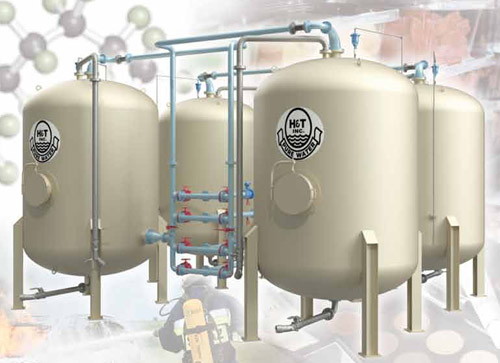PFAS Waste Management for Safer Disposal and Environmental Protection
PFAS Waste Management for Safer Disposal and Environmental Protection
Blog Article
Ingenious PFAS Treatment Solutions for Safer Water
The raising prevalence of PFAS contamination in water materials requires an essential examination of innovative treatment services. Furthermore, emerging bioremediation techniques provide a more sustainable method to tackling PFAS challenges. pfas management.
Summary of PFAS Contamination
PFAS contamination has emerged as a considerable environmental and public health concern. Per- and polyfluoroalkyl compounds (PFAS) are a team of synthetic chemicals known for their determination in the atmosphere and body, leading them to be generally referred to as "forever chemicals." These substances have actually been widely utilized in different sectors, including firefighting foams, water-repellent materials, and food product packaging, mainly as a result of their water- and grease-resistant properties.
The prevalent use PFAS has caused their detection in soil, water supplies, and also in the blood of human beings and animals. Research studies have actually linked PFAS direct exposure to many health and wellness concerns, consisting of developing effects in infants, immune system disorder, and numerous types of cancer. In addition, the ecological determination of these compounds complicates their destruction and removal, increasing concerns regarding long-lasting eco-friendly effects.
Regulative bodies are progressively carrying out rigid standards to keep an eye on and reduce PFAS degrees in alcohol consumption water and other ecological mediums. As recognition of PFAS contamination grows, it has actually ended up being necessary for neighborhoods and industries to seek effective treatment services to reduce direct exposure and protect public health.
Advanced Filtration Technologies
As the urgency to address PFAS contamination magnifies, progressed filtering technologies have actually arised as a critical component in the removal efforts focused on removing these relentless chemicals from water sources. These innovations utilize innovative mechanisms to effectively target and capture PFAS compounds, which are notoriously resistant to conventional treatment methods.
Among the most encouraging strategies is the usage of granular turned on carbon (GAC), which adsorbs PFAS particles because of its high surface and permeable framework. This method has been extensively executed in both local and commercial setups, demonstrating considerable decreases in PFAS focus. Furthermore, ion exchange resins have gained grip, especially developed to selectively bind PFAS ions from water, thus facilitating their elimination.
Membrane layer filtering modern technologies, such as reverse osmosis and nanofiltration, likewise show efficacy in PFAS elimination by literally dividing impurities from water - pfas management. These systems can achieve high levels of pureness, making them appropriate for alcohol consumption water applications
Chemical Treatment Innovations
Numerous chemical therapy developments are being discovered to effectively deal with PFAS contamination in water products. One promising approach entails the use of sophisticated oxidation processes (AOPs), which use effective oxidants such as ozone, hydrogen peroxide, or chlorine dioxide combined with UV light to break down PFAS substances right into much less harmful materials. This technique has actually demonstrated efficacy in laboratory settings, revealing possible for scalability in real-world applications.
An additional ingenious method is the growth of ion-exchange materials especially created to target PFAS. These materials can uniquely adsorb PFAS compounds from water, permitting their elimination during treatment procedures. Recent developments have boosted the performance and capacity of these materials, making them a beneficial option for water therapy centers.
Furthermore, scientists are checking out the usage of chemical agents like persulfate and ferrous ions to boost the deterioration of PFAS in polluted water. These representatives can generate chemical reactions that promote the malfunction of persistent PFAS substances.
Emerging Bioremediation Strategies
Current developments in chemical therapy innovations have actually led the way for exploring bioremediation methods as a feasible alternative for resolving PFAS contamination. Bioremediation utilizes the all-natural metabolic processes of microorganisms to break down or transform pollutants, making it an appealing method for dealing with consistent pollutants like PFAS.
Arising techniques in bioremediation consist of making use of genetically crafted microorganisms that can especially target and break down PFAS compounds. These microbial pressures are being created for their boosted deterioration abilities, boosting the performance of the remediation process. Furthermore, scientists are checking out the possibility of plant-assisted bioremediation, where specific plant types might uptake pfas waste management and sequester PFAS from contaminated dirt and water.
An additional promising approach is the application of bioaugmentation, which entails presenting helpful bacteria right into infected settings to enhance the destruction of PFAS. This method can assist in faster remediation timelines and improve general efficiency.

Governing Structures and Requirements
An extensive governing structure is necessary for properly handling PFAS contamination and making sure public health security. The raising recognition of per- and polyfluoroalkyl compounds (PFAS) as toxic wastes has motivated numerous government and state firms to create criteria that control their visibility in water supplies. The U.S. Epa (EPA) has actually established health advisories and is pursuing establishing enforceable limitations for PFAS in drinking water.
State-level guidelines differ substantially, with some states embracing stricter standards than those recommended by the EPA. These guidelines often include maximum contaminant degrees (MCLs) for particular PFAS compounds, tracking demands, and reporting responsibilities for water utilities. In addition, emerging frameworks concentrate on the removal of contaminated websites, highlighting the requirement for effective treatment modern technologies.

Verdict
Finally, the advancement and application of cutting-edge PFAS therapy remedies are crucial for dealing with the prevalent issue of water contamination. Advanced purification innovations, chemical therapies, and emerging bioremediation methods collectively present a complex approach to effectively lower and break down PFAS levels. As governing structures remain to advance, incorporating these modern technologies will certainly be vital to guard public wellness and restore the integrity of infected water sources, inevitably adding to a cleaner and much safer atmosphere.
Report this page